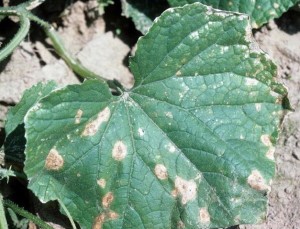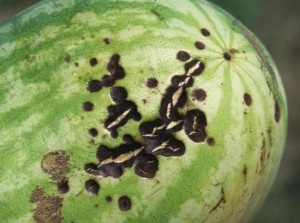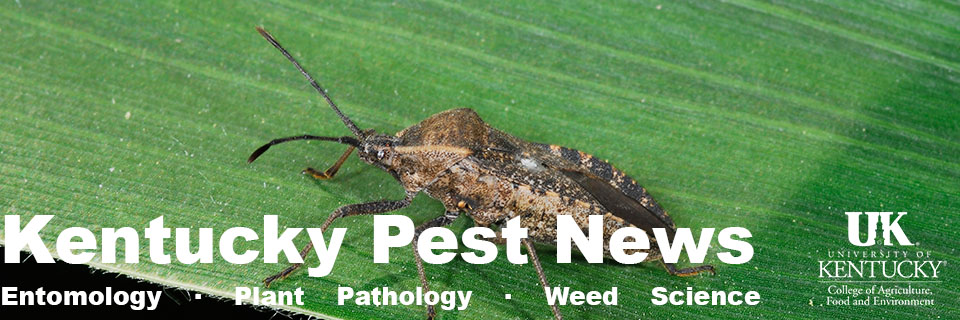Anthracnose of cucurbit crops (cucumber, squash, watermelon, cantaloupe) is a common disease in Kentucky. Cucumbers and melons in home gardens and commercial vegetable production are at the greatest risk. Severe infections can result in complete plant collapse. Preventative practices are critical to prevent damage and yield loss.
Anthracnose Facts
- Symptoms vary depending on cucurbit crop.
- On cucumber, symptoms begin as small, circular lesions on leaves. Lesions expand over time and darken to a brown color (Figure 1). Small, circular and sunken lesions may develop on fruit (Figure 2). In periods of high humidity, pink to salmon-colored spores may develop in lesions. Stems may also become infected, and symptoms include tan-brown, sunken, elongated lesions.
- Diseased watermelon and cantaloupe may have smaller leaf lesions that appear angular and dark in color. Lesions on fruit may be semi-circular with cracks in centers of spots.
- Disease may be introduced via infected crop debris, seed, transplants, or weeds.
- Fungal spores are spread by water, such as irrigation and rain.
- Warm, wet conditions and periods of high humidity favor disease development.
- Anthracnose on cucurbits is caused by the fungal pathogen Colletotrichum orbiculare.


Management
- Purchase certified disease-free seeds or transplants
- Utilize cultivars with resistance to multiple pathogen races of anthracnose
- Manage weeds in and near plantings
- Rotate crops away from cucurbits for a minimum of 2 years
- Increase plant spacing
- Remove and destroy infected plants or plant parts
- Avoid overhead watering
- Clean and sanitize tools, pots, and equipment
- Remove and destroy plant debris at the end of the season
Commercial growers can find information on fungicides in the Vegetable Production Guide for Commercial Growers (ID-36) and the Southeastern U.S. Vegetable Crop Handbook (SEVEW). Homeowners should consult Home Vegetable Gardening (ID-128) for fungicide information or contact a county Extension agent for additional information and recommendations regarding fungicides.
Additional Resources
- IPM Scouting Guide for Common Pests of Cucurbit Crops in Kentucky (ID-91)
- Sustainable Disease Management of Cucurbit Crops in the Home Garden (PPFS-VG-19)
- Home Vegetable Gardening (ID-128)
- Vegetable Production Guide for Commercial Growers (ID-36)
- Southeastern U.S. Vegetable Crop Handbook (SEVEW)
By Kim Leonberger, Plant Pathology Extension Associate, and Nicole Gauthier, Plant Pathology Extension Specialist
